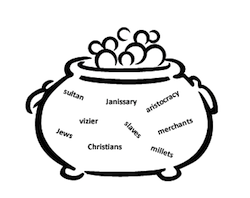
Unit 2: How Trade and Travel Changed the World
Lesson B: Life and Times in the Ottoman Empire
Activity 4: A Patchwork Ottoman World
In Activity 2: Religious Conflicts of Yesterday and Today, you discussed the conflicts created by elements of a diverse society in the Ottoman Empire. Some groups, such as women, had opportunities that did not exist in other areas of the world at the time.
Review your responses to the following questions from Activity 2.
- What was a cause of religious conflict in the Ottoman Empire?
- How was the Ottoman government involved in religious conflict?
- Why may it have been difficult to solve these problems?
In the following activity, you will read a more detailed account of the treatment of different groups in the Ottoman Empire. Some of these groups were non-Muslim, and therefore posed a challenge to the Islamic Ottoman society.
![]() Download the Student Resource: The Ottoman Melting Pot (doc).
Download the Student Resource: The Ottoman Melting Pot (doc).
Directions: Complete the assignment as you read the description below. Be prepared to answer the questions that follow in the next part of the lesson.
Ottoman Empire: A Melting Pot

At the top of Ottoman society was the sultan, or "lord of kings." The Sultan was the Muslim caliph, the highest post in an Islamic society. Osman I formed the early Ottoman Empire in Anatolia (present day Turkey) during the 14th century. Several sultans became wealthy and successful as the empire grew in the Middle East, southeast Europe, and North Africa. Selim I and Suleyman "the Magnificent" ruled the empire during the early 16th century.
The second-most powerful person in the Empire was the Grand Vizier, who served as the Sultan's chief minister in military and administrative affairs.
Government officials and local rulers ruled below the Sultan. Religious officials and other positions in society were organized according to religion, with Muslims receiving more rights than non-Muslims. Merchants, farmers, and other jobs were common, much like societies in other land-based civilizations.
Many people migrated to Ottoman lands because of their toleration for religions and ethnic groups. For example, Jews escaped persecution in Europe in the Ottoman lands. Christians were even allowed to remain in Constantinople after the Christian capital was conquered. Religious minorities were ruled by millets, local councils that ruled over political and legal matters.
Slaves played important roles in Ottoman society, with the select few "luckier" slaves holding positions in a harem. The devshirme system was also considered a form of slavery. The devshirme forcibly took young Christian boys from their families, converted them to Islam, and trained them to serve in the Janissary corps of the military. The Janissaries were known for their skills and victories on the battlefield.
Ottoman policies created a population of mixed ethnicities, religions, art, architecture, and language. The early success of the empire is due partly to this "melting pot" of cultures. At its height, the Ottoman Empire occupied a central location in the world, and reflected a collision of cultures.
Written Activity - Notebook
Answer the question on your Student Resource: The Ottoman Melting Pot.
- How was the Ottoman Empire a "melting pot" of cultures?
![]() When completed, submit the assignment to your teacher as instructed.
When completed, submit the assignment to your teacher as instructed.

